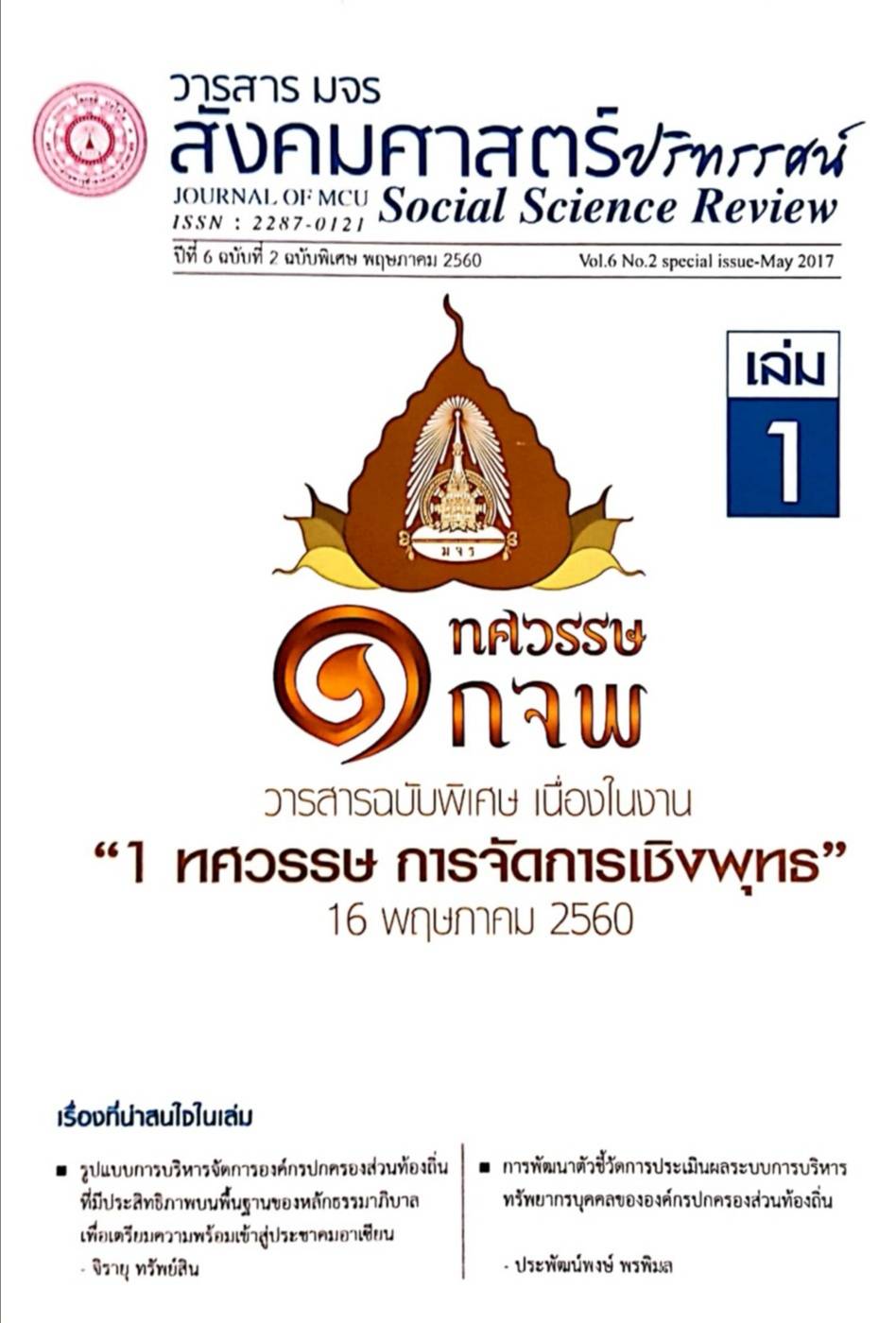การผสมผสานวิถีปฏิบัติและประเพณีทางพุทธศาสนาในพื้นที่ชายแดนไทย-เมียนมา : การส่งเสริมประชาคมสังคมและวัฒนธรรมอาเซียนในบริบทสังคมพหุวัฒนธรรม
คำสำคัญ:
การผสมผสานทางศาสนา, ประชาคมอาเซียน, สังคมพหุวัฒนธรรม, พื้นที่ชายแดน, ไทย- เมียนมาบทคัดย่อ
บทความนี้มีวัตถุประสงค์เพื่อศึกษากระบวนการผสมผสานวิถีปฏิบัติและประเพณีทางพุทธศาสนาในบริบทของสังคมพหุวัฒนธรรม โดยใช้พื้นที่ชายแดนอาเภอแม่สอด จังหวัดตาก
เป็นพื้นที่ศึกษา เพื่อวิเคราะห์แนวทางการสร้างเสริมประชาคมสังคมและวัฒนธรรมอาเซียนในบริบทพื้นที่ชายแดนไทยกับประเทศเมียนมา ผลการศึกษาพบว่าการดาเนินมาตรการเพื่อสร้าง
ประชาคมสังคมและวัฒนธรรมอาเซียนน่าจะมีความเป็นไปได้ง่ายขึ้นสาหรับประเทศสมาชิกที่มีศาสนานิกายเดียวกัน เพราะปัจจัยทางศาสนาและวัฒนธรรมเป็นสื่อสาคัญที่จะเชื่อมประชาชนให้
สามารถอยู่ร่วมกันได้อย่างสงบสุข ดังจะเห็นได้จากแบบแผนบูรณาการการสร้างและใช้พื้นที่ทางศาสนา ตลอดจนการผสมผสานวิถีปฏิบัติและประเพณีทางศาสนาทั้งในหมู่พระสงฆ์และพุทศาสนิก
ชนชาวไทยและชาวเมียนมา ความรู้ความเข้าใจต่อแนวทางการบูรณาการและผสมผสานวิถีปฏิบัติและประเพณีทางศาสนาในพื้นที่ชายแดนแม่สอดจะเป็นประโยชน์อย่างมากต่อการเป็นฐานคิดใน
การสร้างเสริมให้คนไทยพร้อมที่จะเข้าร่วมเป็นพลเมืองอาเซียนอย่างมีศักดิ์ศรีและสิทธิเท่าเทียมกับชาติอื่นภายใต้ประชาคมสังคมและวัฒนธรรมอาเซียน
เอกสารอ้างอิง
สนับสนุนการวิจัย.
งามพิศ สัตย์สงวน. (2543.) หลักมานุษยวิทยาวัฒนธรรม. กรุงเทพฯ: จุฬาลงกรณ์มหาวิทยาลัย.
ชูพินิจ เกษมณี. (2555). ความหลากหลายทางวัฒนธรรมในสังคมพหุลักษณ์. กรุงเทพฯ: กรม
ส่งเสริมวัฒนธรรม.
ฐิรวุฒิ เสนาคา. (2549). “โลกาภิวัตน์กับตรรกะใหม่ของความรุนแรง” วัฒนธรรมไร้อคติ ชีวิตไร้
ความรุนแรง. กรุงเทพฯ: ศูนย์มานุษยวิทยาสิรินธร.
ถนอมศักดิ์ สู่ภิภักดิ์. (2546). “บทบาทของพระธรรมวิทยากรต่อการปลูกฝังและพัฒนาคุณธรรม
เยาวชน” ปริญญาสังคมสงเคราะห์ศาสตรมหาบัณฑิต สาขาการบริหารและนโยบาย
สวัสดิการสังคม. บัณฑิตวิทยาลัย : มหาวิทยาลัยธรรมศาสตร์.
ปาริชาด สุวรรณบุปผา. (2549). ศาสนเสวนา กรุงเทพฯ: ศูนย์ศึกษาและพัฒนาสันติวิธี
มหาวิทยาลัยมหิดล.
พระธรรมปิฎก (ป.อ. ปยุตโต). (2540). พุทธวิธีแก้ปัญหาเพื่อศตวรรษที่ 21. กรุงเทพฯ:
สานักพิมพ์มูลนิธิพุทธธรรม.
แพรภัทร ยอดแก้ว. (2555). “คุณลักษณะพลเมืองอาเซียน” เอกสารประกอบการสอน รหัสวิชา
2000111 วิชาอาเซียนศึกษา (ASEAN Studies). คณะมนุษยศาสตร์และสังคมศาสตร์
มหาวิทยาลัยราชภัฏนครปฐม.
ยศ สันตสมบัติ. (2556). มนุษย์กับวัฒนธรรม. เชียงใหม่: มหาวิทยาลัยเชียงใหม่.
ศุภสิทธิ์ วนชยางค์กูล. (2549). “พระภิกษุข้ามถิ่นอัตลักษณ์ข้ามแดน เปรียบเทียบพระภิกษุพม่า
และพระภิกษุ ไทใหญ่ในภาคเหนือของประเทศไทย” ปริญญาศิลปศาสตร์มหาบัณฑิต.
บัณฑิตวิทยาลัย: จุฬาลงกรณ์มหาวิทยาลัย.
สมศักดิ์ ศรีสันติสุข. (2551). การศึกษาสังคมและวัฒนธรรม แนวความคิด วิธีวิทยา และทฤษฎี.
ขอนแก่น: มหาวิทยาลัยขอนแก่น.
อมรา พงศาพิชญ์. (2547). ความหลากหลายทางวัฒนธรรม (กระบวนทัศน์และบทบาทในประชา
สังคม). กรุงเทพฯ: จุฬาลงกรณ์มหาวิทยาลัย.
Appadurai, Arjun. (1996). Modernity at Large: Cultural Dimensions of Globalization.
Public Worlds Volume 1, Minneapolis, London: University of Minnesota
Press.
Dirlik, Arif. (2009). “Asians on the Rim: Transnational Capital and Local Community
in the Making of Contemporary Asian America,” in Jean Y.W., Shen Wu and
T. Chen (editors), Asian American Studies Now: A Critical Reader. Piscataway,
NJ: Rutgers University Press.
Thuzar, Moe. (2015). “ASEAN Community 2015: What’s In It For” ISEAS Perspective.
#9 (13 February 2015). Singapore: Institute of Southeast Asian Studies.
ดาวน์โหลด
เผยแพร่แล้ว
รูปแบบการอ้างอิง
ฉบับ
ประเภทบทความ
สัญญาอนุญาต
ลิขสิทธิ์ (c) 2020 วารสาร มจร สังคมศาสตร์ปริทรรศน์

อนุญาตภายใต้เงื่อนไข Creative Commons Attribution-NonCommercial-NoDerivatives 4.0 International License.
เพื่อให้เป็นไปตามกฎหมายลิขสิทธิ์ ผู้นิพนธ์ทุกท่านต้องลงลายมือชื่อในแบบฟอร์มใบมอบลิขสิทธิ์บทความให้แก่วารสารฯ พร้อมกับบทความต้นฉบับที่ได้แก้ไขครั้งสุดท้าย นอกจากนี้ ผู้นิพนธ์ทุกท่านต้องยืนยันว่าบทความต้นฉบับที่ส่งมาตีพิมพ์นั้น ได้ส่งมาตีพิมพ์เฉพาะในวารสาร มจร สังคมศาสตร์ปริทรรศน์ เพียงแห่งเดียวเท่านั้น หากมีการใช้ภาพหรือตารางหรือเนื้อหาอื่นๆ ของผู้นิพนธ์อื่นที่ปรากฏในสิ่งตีพิมพ์อื่นมาแล้ว ผู้นิพนธ์ต้องขออนุญาตเจ้าของลิขสิทธิ์ก่อน พร้อมทั้งแสดงหนังสือที่ได้รับการยินยอมต่อบรรณาธิการ ก่อนที่บทความจะได้รับการตีพิมพ์ หากไม่เป็นไปตามข้อกำหนดเบื้องต้น ทางวารสารจะถอดบทความของท่านออกโดยไม่มีข้อยกเว้นใดๆ ทั้งสิ้น





